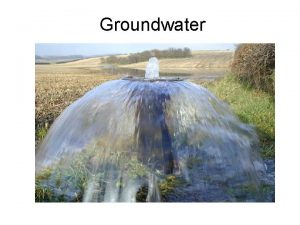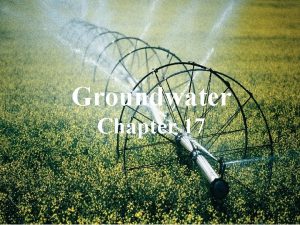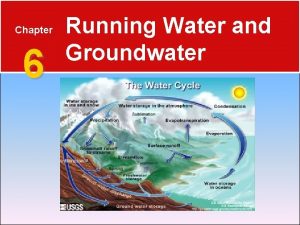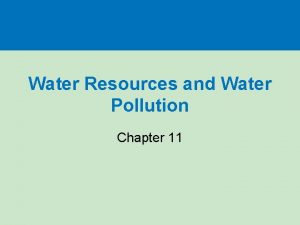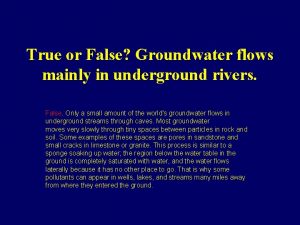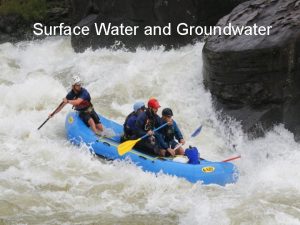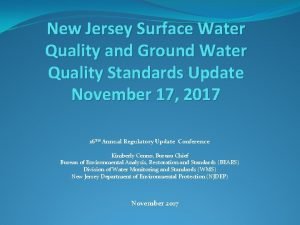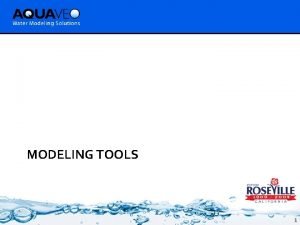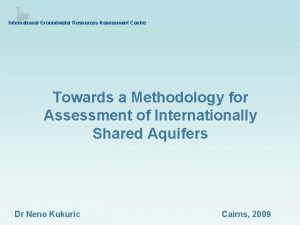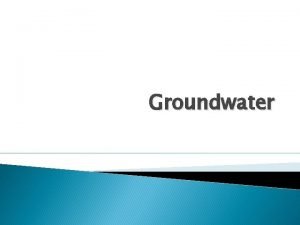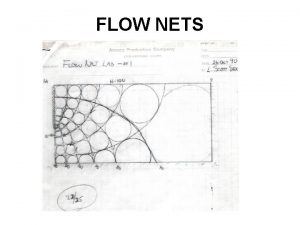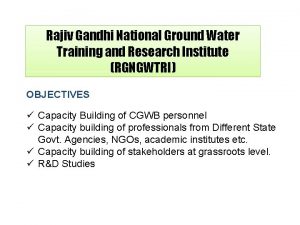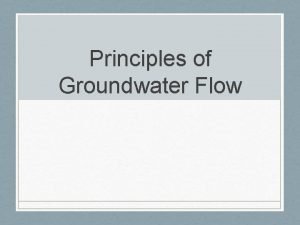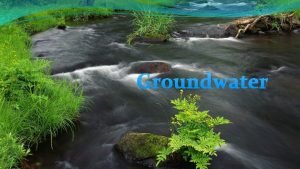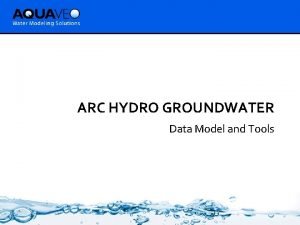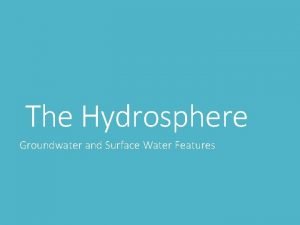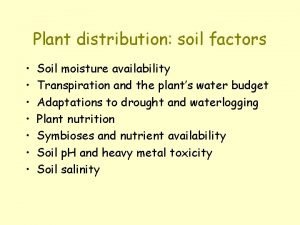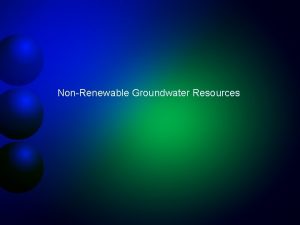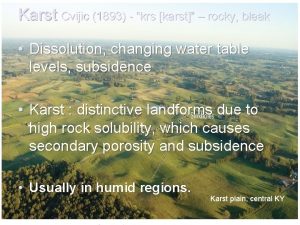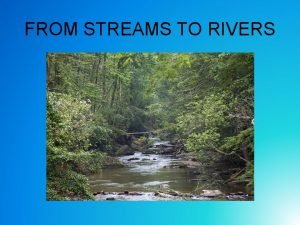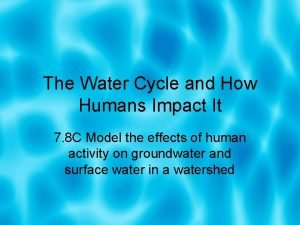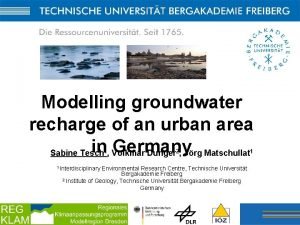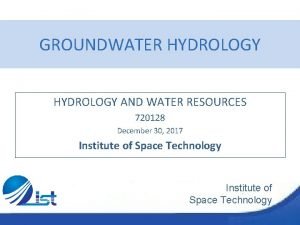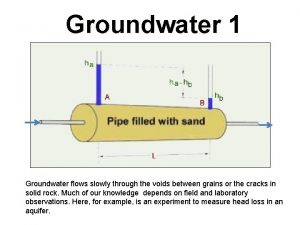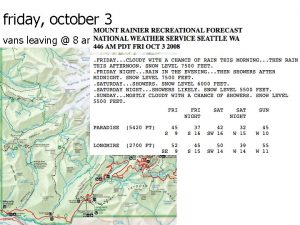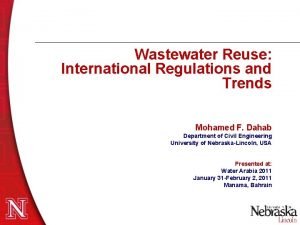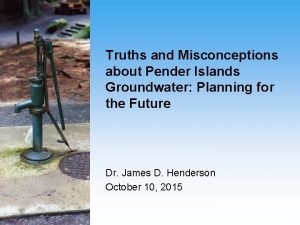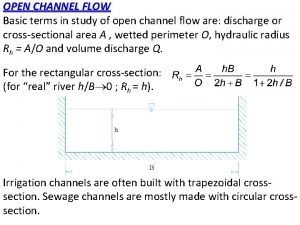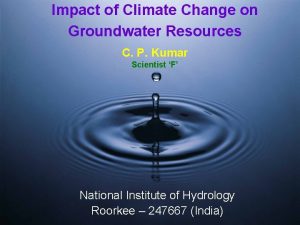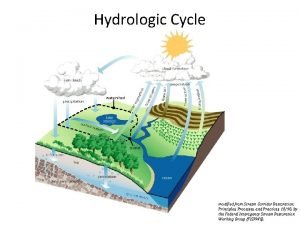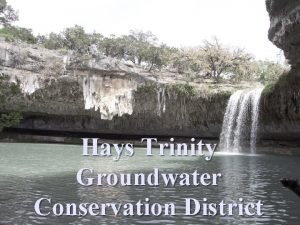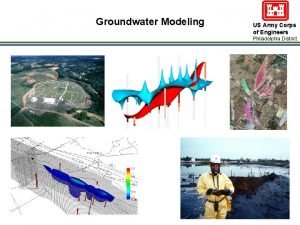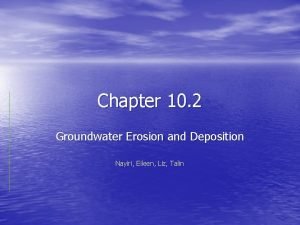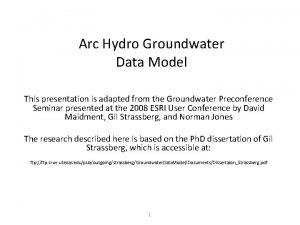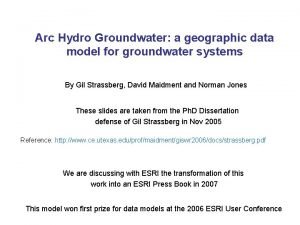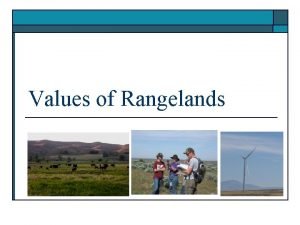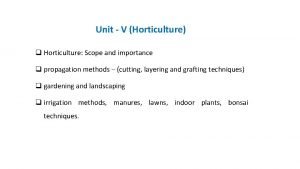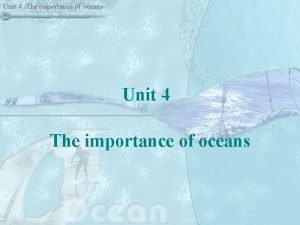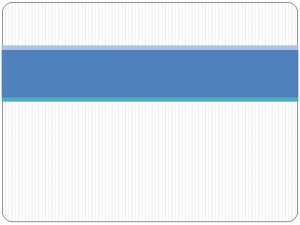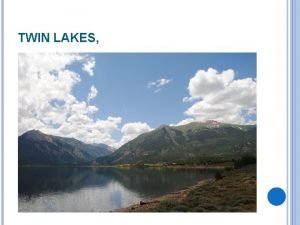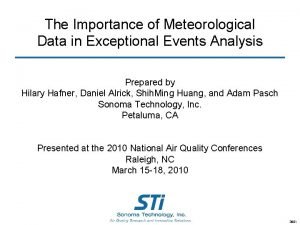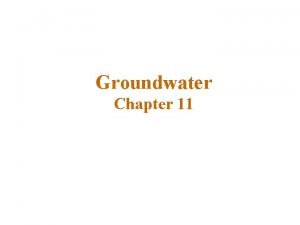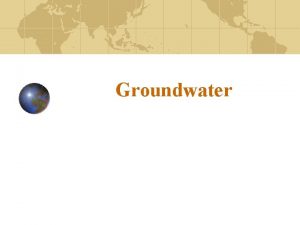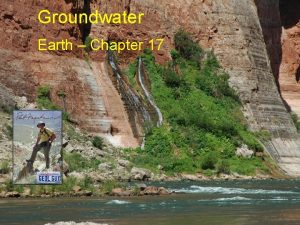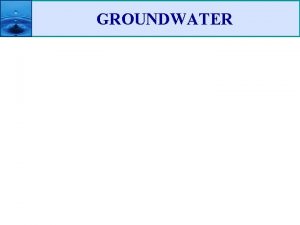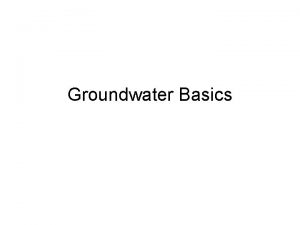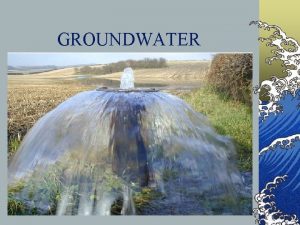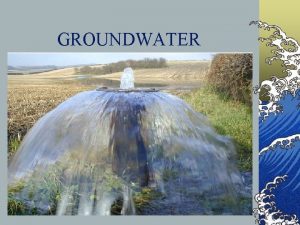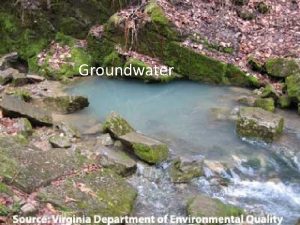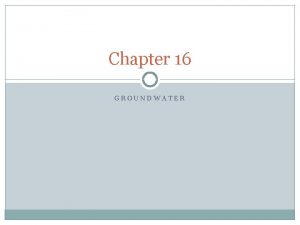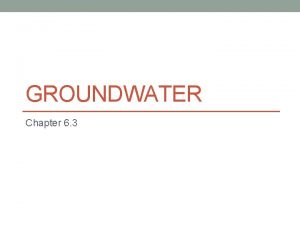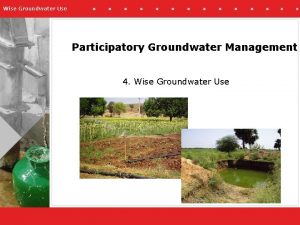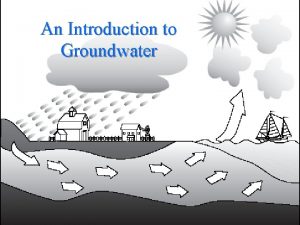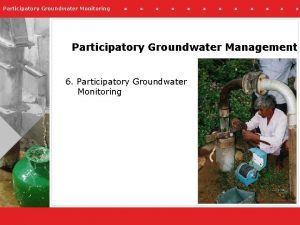Groundwater Chapter 17 Importance of groundwater Groundwater is

















































































- Slides: 81

Groundwater Chapter 17

Importance of groundwater Groundwater is water found in the pores of soil, sediment & rocks; it also occurs in narrow fractures in bedrock Groundwater is the largest reservoir of fresh water that is readily available to humans

Distribution of Water on the Planet Earth

Distribution of Fresh Water in the Hydrosphere

Importance of groundwater Geological role of groundwater • As an erosional agent, groundwater can dissolve out – Sinkholes – Caverns • Groundwater serves as an equalizer of streamflow

Groundwater Creates Caves & Sinkholes and Serves to Equalize & Replenish the Flow of Streams & Rivers

Distribution of groundwater Belt of soil moisture – water held by molecular attraction on soil particles in the near-surface zone. This is one of the prime sources of water for most plants

Distribution of groundwater Zone of aeration (Vadose Zone) • Area above the water table • Includes the capillary fringe and the belt of soil moisture • Water cannot be pumped from the vadose zone because it clings too tightly to the rock & soil particles

Distribution of groundwater Capillary fringe • Extends upward from the water table • Groundwater is held by surface tension in tiny passages between grains of soil or sediment

Distribution of groundwater Zone of saturation • Formation – Water reaches a zone where all of the open spaces in sediment and rock are completely filled with water – Water within the pores is called groundwater • Water table – the upper limit of the zone of saturation

Distribution of Groundwater The Shape of the Water Table Usually Roughly Mimincs Topography. The Water Table Falls During Periods of Prolonged Drought

The water table is the upper limit of the zone of saturation Variations in the water table • Depth is highly variable – Varies seasonably and from year to year • Shape is usually a subdued replica of the surface topography

The water table Variations in the water table • Factors that contribute to the irregular surface of the water table – Water tends to “pile up” or build up beneath high areas (topographic “highs”) – Variations in rainfall – Variations in permeability from place to place

Mapping the Water Table (A) Plot Well Locations & Elevations of Water Table ) Draw Water Table Contour Lines at Regular Intervals. Dashed Lines Show Projected Groundwater Flow, Which Is Roughly Perpendicular to the Water Table Contours

The water table Interaction between groundwater and streams • Constitutes a basic link in the hydrologic cycle • Three types of interactions – Gaining streams – gain water from the inflow of groundwater through the streambed – Losing streams – lose water to the groundwater system by outflow through the streambed

Interaction Between Groundwater & Streams (A) Gaining Streams Receive Water from the Groundwater System (B) Losing Streams Lose Water to the Groundwater System (C) When Losing Streams Are Separated From the Groundwater System, a Bulge May Form in the Water Table Beneath the Stream

The water table Interaction between groundwater and streams • Combinations – A combination of the first two – a stream gains in some sections and loses in other areas – Most streams are “combinations”

Drought & the Hydrologic System Drought impacts all of society, agriculture first, followed by everyone who depends on surface or subsurface water supplies. As world population continues to increase, drought and lack of adequate water supplies are becoming one of mankind’s most serious problems.

Sequence of drought impact – after meteorological drought, agriculture is affected first, followed by reduction in stream flow, etc. When meteorologic drought ends, agricultural drought quickly ends too. It takes much longer to end hydrologic drought

Factors influencing the storage and movement of groundwater Porosity – percentage of total volume of rock or sediment that consists of pore spaces • Determines how much groundwater can be stored • Variations can be considerable over short distances

Porosity of common sediments and rocks, how much fluid they will yield (release), and how much they will retain.

Factors influencing the storage and movement of groundwater Permeability, aquitards, and aquifers • Permeability – the ability of a material to transmit a fluid • Aquitard (SEAL) – an impermeable layer that hinders or prevents water movement (such as clay) • Aquifer (RESERVOIR) – permeable rock strata or sediment that transmits groundwater freely (such as sands and gravels)

Movement of groundwater Exceedingly slow – typical rate of movement is a few centimeters per day Energy for the movement is provided by the force of gravity Darcy’s Law – if permeability remains uniform, the velocity of groundwater will increase as the slope of the water table increases

Groundwater Movement Through Uniformly Permeable Material – a Compromise Between the Pull of Gravity and Water Movement Toward Areas of Reduced Pressure

Movement of groundwater Darcy’s Law • Hydraulic gradient – the water table slope, determined by dividing the vertical difference between the recharge and discharge points by the length of flow between these points • Hydraulic head – the vertical difference between the recharge and discharge points

The hydrologic gradient is determined by measuring the difference in elevation between two points on the water table and dividing by the distance between them.

Movement of groundwater The movement of groundwater is measured directly using • Various dyes • Carbon-14

Features associated with groundwater Springs • Occur where the water table intersects Earth’s surface • Natural outflow of groundwater • Can be caused by an aquitard creating a localized zone of saturation which is called a perched water table

A Spring in Bedded Strata in Marble Canyon, Arizona Water Runs Out at the Surface Because it Has Encountered an Aquitard (Impermeable Layer) and Can Not Move Downward

Springs Can Result When an Aquitard Creates a Locally Perched Water Table

Features associated with groundwater Hot springs • Water is 6 -9 o. C warmer than the mean annual air temperature of the locality • The water for most hot springs is heated by cooling of igneous rock

Travertine (Limestone) Deposits Around a Hot Spring

Features associated with groundwater Geysers • Intermittent hot springs • Water erupts with great force • Occur where extensive underground chambers exist within hot igneous rock • Groundwater heats, expands, changes to steam, and erupts

Old Faithful Geyser in Yellowstone National Park Erupts @ 12, 000 Gallons of Hot Water & Steam About Once an Hour

Idealized Diagram of a Geyser (A) Water near the Bottom of the System is Heated to Near the Boiling Point (B) Water Higher in the system is Heated. It Expands and Flows out the Top, Reducing Pressure on Water at the Bottom (C) Under Reduced Pressure, Bottom Water Boils and the Resulting Steam Expands, Causing an Eruption

Distribution of Hot Springs & Geysers in the Continental United States

Features associated with groundwater Geysers • Chemical sedimentary rock accumulates at the surface when the geyser erupts – Siliceous sinter (from dissolved silica) – Travertine (from dissolved calcium carbonate)

Travertine (Limestone) Deposits at Mammoth Hot Springs, Yellowstone National Park

Features associated with groundwater Wells • To ensure a continuous supply of water, a well must penetrate below the water table • Pumping of wells can cause – Drawdown (lowering) of the water table – Cone of depression in the water table

Formation of a Cone of Depression in the Water Table due to Pumping from a Well

Features associated with groundwater Artesian well – a situation in which groundwater under pressure rises above the level of the aquifer • Types of artesian wells – Nonflowing – pressure surface is below ground level – Flowing – pressure surface is above the ground • Not all artesian systems are wells, artesian springs also exist

In some cases, water flows freely to the surface when an artesian well is drilled.

Artesian Wells Resulting from an Inclined Aquifer

A Flowing Artesian Well in South Dakota During Early Days of Water Production from the Dakota Sandstone

Elevated City Water Tanks Function as Artesian Delivery Systems

Problems associated with groundwater withdrawal Groundwater is the principle source of fresh water in many parts of the world. It has been a renewable resource, but people may need to rethink this scenario

Widespread Use of Groundwater in Irrigation Has Produced a Major Crop Expansion – But at What Price?

Problems associated with groundwater withdrawal Treating groundwater as a nonrenewable resource • In many places the water available to recharge the aquifer falls significantly short of the amount being withdrawn

In some agricultural regions, water is pumped from the ground faster than it is replenished. In such instances, groundwater is being treated as a nonrenewable resource

Distribution of Major Texas Aquifers Position of Ector & Midland Counties Shown in Red Box Ogallala Gulf Coast Edwards BFZ (outcrop) Edwards BFZ (downdip) Carrizo-Wilcox (outcrop) Carrizo-Wilcox (downdip) Trinity (outcrop) Trinity (downdip) Edwards-Trinity Plateau (outcrop) Edwards-Trinity Plateau (downdip) Seymour Hueco-Mesilla Bolson Cenozoic Pecos Alluvium

The Ogallala Aquifer is widely used in the Texas Panhandle for growing irrigated crops. Water is withdrawn much faster than it is replenished. At some point, we will be unable to sustain irrigated agriculture on the high plains.

Problems associated with groundwater withdrawal Subsidence • Ground sinks when water is pumped from wells faster than natural recharge processes can replace it (San Joaquin Valley of California)

Excessive Ground Water Usage in San Joaquin Valley, California Caused Land Surface to Subside by over 9 meters (21 feet) Between 1925 & 1975

Problems associated with groundwater withdrawal Saltwater contamination • Excessive groundwater withdrawal causes saltwater to be drawn into wells, thus contaminating the freshwater supply • This is primarily a problem is coastal areas

Salt Water Contamination due to Excessive Well Pumping

Other Sources of Groundwater Contamination One common source is sewage • Extremely permeable aquifers, such as coarse gravel, have such large openings that groundwater may travel long distances without being cleaned • Sewage often becomes purified as it passes through a few dozen meters of an aquifer composed of sand or permeable sandstone

Most Contaminants Can Be Removed As Water Moves Through the Ground, But Not Always

Groundwater contamination Sinking a well can lead to groundwater pollution problems Other sources and types of contamination include substances such as • Highway salt • Fertilizers • Pesticides • Chemical and industrial materials

Heavy Pumping Can Change the Direction of Groundwater Flow, Producing Contamination Where None Existed Previously

Sewage is not the Only Source of Contamination; Agricultural Chemicals and Materials Leached from Landfills Can Also Pollute Groundwater

Geologic work of groundwater Groundwater dissolves rock • Groundwater is often mildly acidic – Contains weak carbonic acid – Forms when rainwater dissolves carbon dioxide from the air and from decaying plants • Carbonic acid reacts with calcite in limestone to form calcium bicarbonate, a soluble material

Geologic work of groundwater Caverns • Most caverns are originally created by acidic groundwater dissolving soluble rock at or just below the surface in the zone of saturation

Geologic work of groundwater Cave Decorations (Speleothems) Form in the Zone of Aeration (vadose zone) • Features found within caverns – Composed of dripstone (travertine) – Calcite deposited as dripping water evaporates – Collectively, they are called speleothems – Includes stalactites (hanging from the ceiling) and stalagmites (form on the floor of a cavern)

Speleothems Form From Dripping Water in the Zone of Aeration

“Soda straws” in Carlsbad Caverns National Park

Speleothems in Carlsbad Caverns National Park

Geologic work of groundwater Karst topography • Landscapes that to a large extent have been shaped by the dissolving power of groundwater • Some common features include – Irregular terrain – Sinkhole or sinks (formed by groundwater slowly dissolving the bedrock often accompanied by collapse) – Striking lack of surface drainage (streams)

Aerial View of Water-Filled Sinkholes in Karsted Limestone Terraine. Sometimes the Sinkholes Form in Very Inconvenient Places

Development of Karst Topography

Extremely Mature “Tower” Karst in China

Groundwater Resources in Texas

Distribution of Groundwater in Texas Groundwater is the major source of water in the western half of Texas, where evaporation exceeds precipitation and there are very few permanent flowing streams In the eastern half of Texas, much higher rainfall results in permanent lakes and streams that source much of the potable water

Average Annual Rainfall in Texas Ranges from <8” in the West to 56” in the East. Midland/Odessa’s Average Is 14. 5”

Major Rivers, River Drainage Basins, & Annual Rainfall in Texas. Location of Ector & Midland Counties Shown in Red Box

Major River Drainage Basins in Texas. Canadian Red Trinity Brazos Colorado Sulphur Sab Cypress ine Neches Rio Grande Sa n San Jacinto Gu ad alu ton pe io An Nueces Neches. Trinity Lavaca San Jacinto. Brazos-Colorado-Lavaca-Guadalupe San Antonio Nueces-Rio Grande Red Dashed Line Marks Approximate Boundary Between Permanent Streams & Ephemeral Streams Ector & Midland Counties Shown in Red Box

Vegetative Cover in Texas No Trees Minimum Annual Rainfall Needed to Support Trees is @ 20 “ in Southern Texas & 30” in Northern Texas Location of Ector & Midland Counties Shown in Red Box

Legend to Accompany Map of Vegetative Cover in Texas Dashed Line Marks Change from “Tree Dominated” Vegetation Types of Eastern Texas to “Brush & Mesquite” Dominated Vegetation of Western Texas

Texas Aquifers Ector & Midland Counties Are Primarily Supplied by the Ogallala, Edwards Trinity and Pecos River Alluvium Ector & Midland Counties Shown in Red Box

Legend for Texas Aquifers

Characteristics of the Major Texas Aquifers

Geologic Map of Eastern Midland & Glasscock Counties - Note Numerous Ephemoral Stream Beds & Sinkholes
 Uses of ground water
Uses of ground water Cone of depression water table
Cone of depression water table Chapter 6 running water and groundwater
Chapter 6 running water and groundwater Zone of areation
Zone of areation How we can reduce water pollution
How we can reduce water pollution True or false: groundwater can flow.
True or false: groundwater can flow. Running water and groundwater
Running water and groundwater Nj groundwater quality standards
Nj groundwater quality standards Modflow analyst
Modflow analyst Groundwater assessment methodology
Groundwater assessment methodology Groundwater label
Groundwater label Septic tank contamination groundwater
Septic tank contamination groundwater Groundwater flow net
Groundwater flow net A tiny groove in soil made by flowing water
A tiny groove in soil made by flowing water How is the carbon cycle similar to the water cycle brainpop
How is the carbon cycle similar to the water cycle brainpop Rajiv gandhi groundwater raipur
Rajiv gandhi groundwater raipur Total head equation
Total head equation Groundwater porosity
Groundwater porosity Arc hydro groundwater
Arc hydro groundwater Surface water features
Surface water features Lenticels
Lenticels Is groundwater renewable or nonrenewable
Is groundwater renewable or nonrenewable Groundwater table
Groundwater table How does groundwater rejoin the water cycle
How does groundwater rejoin the water cycle Human impact on groundwater
Human impact on groundwater Groundwater
Groundwater Cut bank geography
Cut bank geography Groundwater system
Groundwater system Groundwater recharge
Groundwater recharge Groundwater
Groundwater Darcy law
Darcy law Base level river
Base level river Groundwater recharge pdf
Groundwater recharge pdf Groundwater
Groundwater Groundwater flow definition
Groundwater flow definition Iot iran
Iot iran Groundwater mining
Groundwater mining Water budget equation
Water budget equation Lower trinity groundwater conservation district
Lower trinity groundwater conservation district Us army corps of engineers philadelphia district
Us army corps of engineers philadelphia district Groundwater information network
Groundwater information network Groundwater erosion and deposition
Groundwater erosion and deposition Arc hydro groundwater
Arc hydro groundwater Arc hydro groundwater
Arc hydro groundwater Summary of chapter 8 and 9 lord of the flies
Summary of chapter 8 and 9 lord of the flies Chapter 10 nutrition for health
Chapter 10 nutrition for health Literature review
Literature review Ivan perry
Ivan perry Objectives of work immersion portfolio
Objectives of work immersion portfolio Weather instrument
Weather instrument 5 importance of rangeland
5 importance of rangeland The importance of user interface
The importance of user interface Scope of horticulture
Scope of horticulture What is the importance of follower readiness
What is the importance of follower readiness Importance of pacific ocean
Importance of pacific ocean Discuss the need for accountancy for lawyers
Discuss the need for accountancy for lawyers Importance of osmosis
Importance of osmosis Turns a claim into a suggestion
Turns a claim into a suggestion Middleton maneuver spleen
Middleton maneuver spleen Biographical criticism definition
Biographical criticism definition Definition of tourism
Definition of tourism Aviation tool control
Aviation tool control Education in values means the cultivation of affectivity
Education in values means the cultivation of affectivity Nature of entrepreneurship
Nature of entrepreneurship Olericulture jobs
Olericulture jobs Importance of requirements
Importance of requirements Importance of quality control in pharmaceutical industry
Importance of quality control in pharmaceutical industry Importance of order of draw
Importance of order of draw Importance of meteorological data
Importance of meteorological data Importance of food quality and safety
Importance of food quality and safety Importance of file format
Importance of file format Importance of faculty in higher education
Importance of faculty in higher education Dramatic irony in the importance of being earnest
Dramatic irony in the importance of being earnest The importance of being earnest characters
The importance of being earnest characters Who is the protagonist in the importance of being earnest
Who is the protagonist in the importance of being earnest Examples of hyperbole in the importance of being earnest
Examples of hyperbole in the importance of being earnest Themes importance of being earnest
Themes importance of being earnest The importance of being earnest title pun
The importance of being earnest title pun The importance of being earnest summary act 1
The importance of being earnest summary act 1 10 importance of agriculture
10 importance of agriculture What is the importance of advocacy in a community
What is the importance of advocacy in a community Concept school
Concept school
